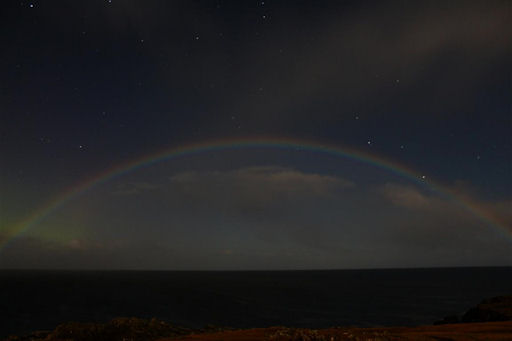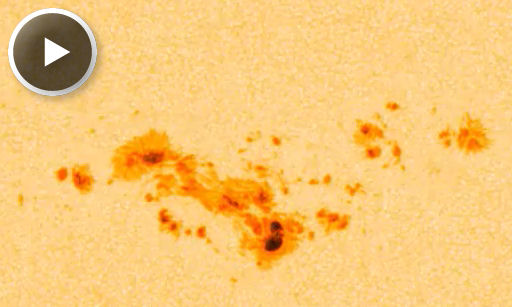Listen to radar echoes from satellites and meteors, live on listener-supported Space Weather Radio. | | |
DECLINING CHANCE OF FLARES: Big sunspot AR1618 is in decay, and it hasn't unleashed a strong flare in more than 24 hours. Nevertheless, the sunspot retains a complex ('beta-gamma-delta' class) magnetic field that harbors energy for X-class eruptions. Significant flaring is still possible this weekend. Solar flare alerts: text, voice.
GEOMAGNETIC STORM WATCH: A geomagnetic storm is brewing around Earth's poles following a CME strike on Nov. 23rd. A second CME is en route, due to arrive on Nov. 24th. NOAA forecasters say there is a 65% chance that the second strike will trigger strong storms at high latitudes. Aurora alerts: text, voice.
Auroras from the first CME strike on Nov. 23rd were weak. On the Isle of Lewis in the Outer Hebrides, photographer John Gray knew just where to look--at the end of the rainbow:

"It was not a very strong aurora, but there all the same," says Gray. "I hope it gets stronger [when the second CME arrives]."
For readers who are puzzled by the apparition of a rainbow at night: This is a lunar rainbow or 'moonbow' caused by bright moonlight reflecting from water droplets in distant rain clouds. Auroras are never found at the end of daytime rainbows, but the end of a lunar rainbow is often a good place to look.
Realtime Aurora Photo Gallery
MUST-SEE SUNSPOT MOVIE: A sunspot, like AR1618, is a vast island of magnetism floating on the surface of the sun. Magnetic fields bubble up from the sun's interior to form the sunspot's dark cores much like a Pacific island forming from the lava of an undersea volcano. Phil Scherrer, a member of the Solar Dynamics Observatory science team at Stanford Unniversity, has prepared an 8-day movie showing the genesis of AR1618:

A companion movie shows the region's magnetic development. In the movie, which Scherrer made using data from SDO's Helioseismic and Magnetic Imager (HMI), white denotes positive polarity, black denotes negative. Places with mixed polarities are where the magnetic fields can reconnect and erupt, producing solar flares.
Realtime Space Weather Photo Gallery
Realtime Eclipse Photo Gallery
Realtime Noctilucent Cloud Photo Gallery
[previous years: 2003, 2004, 2005, 2006, 2007, 2008, 2009, 2011]
Potentially Hazardous Asteroids (
PHAs) are space rocks larger than approximately 100m that can come closer to Earth than 0.05 AU. None of the known PHAs is on a collision course with our planet, although astronomers are finding
new ones all the time.
On November 24, 2012 there were potentially hazardous asteroids.
Notes: LD means "Lunar Distance." 1 LD = 384,401 km, the distance between Earth and the Moon. 1 LD also equals 0.00256 AU. MAG is the visual magnitude of the asteroid on the date of closest approach. | | The official U.S. government space weather bureau |
| | The first place to look for information about sundogs, pillars, rainbows and related phenomena. |
| | Researchers call it a "Hubble for the sun." SDO is the most advanced solar observatory ever. |
| | 3D views of the sun from NASA's Solar and Terrestrial Relations Observatory |
| | Realtime and archival images of the Sun from SOHO. |
| | from the NOAA Space Environment Center |
| | the underlying science of space weather |

